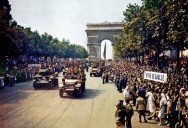This Day In History – October 19th

DAGUERREOTYPE: FIRST COMMERCIALLY SUCCESSFUL PHOTOGRAPHIC PROCESS RELEASED ‘FREE TO THE WORLD’ – OCTOBER 19, 1839

An 1837 daguerreotype | Photograph by LOUIS DAGUERRE
The daguerreotype was the first commercially successful photographic process. The image is a direct positive made in the camera on a silver plated copper plate. The raw material for plates was called Sheffield plate, plating by fusion or cold-rolled cladding and was a standard hardware item produced by heating and rolling silver foil in contact with a copper support. The surface of a daguerreotype is like a mirror, with the image made directly on the silvered surface.
The process was developed by Louis Daguerre together with Joseph Nicéphore Niépce. Niepce had produced the first photographic image in the camera obscura using asphaltum on a copper plate sensitised with lavender oil that required exposures as long as eight hours.
Daguerre did not patent and profit from his invention in the usual way. Instead, it was arranged that the French government would acquire the rights in exchange for a lifetime pension. The government would then present the daguerreotype process “free to the world” as a gift to mankind, which it did on August 19, 1839. However, on August 14, 1839, Miles Berry, acting on Daguerre’s behalf, filed for a patent in England, which consequently became the only place on Earth where the purchase of a license was legally required. [Source]

1840-1841 Camerae obscurae and plates for Daguerreotype called “Grand Photographe” produced by Charles Chevalier. Photograph by Edal Anton Lefterov
FIRST AUTOMOBILE RACE AT INDIANAPOLIS MOTOR SPEEDWAY TAKES PLACE – OCTOBER 19, 1909

Photograph by Indianapolis Motor Speedway
The Indianapolis Motor Speedway, located in Speedway, Indiana (an enclave suburb of Indianapolis) in the United States, is the home of the Indianapolis 500-Mile Race and the Brickyard 400. It has existed since 1909, and is the original Speedway, the first racing facility so named. With a permanent seating capacity for more than 257,000 people and infield seating that raises capacity to approximately 400,000, it is the largest and highest-capacity sporting facility in the world.
Considered relatively flat by American standards, the track is a two-and-a-half-mile, nearly rectangular oval with dimensions that have remained essentially unchanged since its inception: four 1/4-mile turns, two 5/8-mile long straightaways between the fourth and first and second and third turns, and two 1/8-mile short straightaways, termed “short chutes,” between the first and second, and third and fourth turns.
Since August 19, 1909, 248 automobile races have taken place, with 137 separate drivers winning. After winning his fifth United States Grand Prix at Indianapolis in 2006, Formula One driver Michael Schumacher holds the record for most victories between the three major events (Indianapolis 500, Brickyard 400 and the F1 USGP), with all taking place on the Formula One version of the road course. [Source]

Photograph by Rick Dikeman
AFGHANISTAN GAINS FULL INDEPENDENCE FROM THE UK – OCT. 19, 1919

Aerial of small section of Kabul | Photograph by S.K. Vemmer (U.S. Department of State)
Afghanistan, officially the Islamic Republic of Afghanistan, is a landlocked country in South and Central Asia. With a population of about 28 million, it has an area of 647,500 km2, making it the 42nd most populous and 41st largest nation in the world. It is bordered by Pakistan in the southeast, Iran in the west, Turkmenistan, Uzbekistan and Tajikistan in the north, and China in the far northeast. The territory that now forms Afghanistan has been an ancient focal point of the Silk Road and human migration. Archaeologists have found evidence of human habitation from as far back as 50,000 BC. Urban civilization may have begun in the area as early as 3,000 to 2,000 BC
In the late 19th century, Afghanistan became a buffer state in the “Great Game” between the British and Russian empires. On August 19, 1919, following the third Anglo-Afghan war and the signing of the Treaty of Rawalpindi, the nation regained control over its foreign policy from the British. [Source]
WWII ‘LIBERATION OF PARIS’ BEGINS – OCTOBER 12, 1964

Photograph by Jack Downey, U.S. Office of War Information
The Liberation of Paris (also known as the Battle for Paris) took place during World War II from 19 August 1944 until the surrender of the occupying German garrison on 25 August. It is regarded as the last battle in the Campaign for Normandy and the transitional conclusion of the Allied invasion breakout in Operation Overlord into a broad-fronted general offensive. The capital region of France had been administered by Nazi Germany since the Second Compiègne armistice in June 1940 when Germany occupied the north and west of France and when the Vichy regime was created in the city of Vichy in central France.
The liberation started with an uprising by the French Resistance against the German garrison. On 24 August, the French Forces of the Interior (FFI) received backup from the Free French Army of Liberation and from the United States’ 4th Infantry Division. This battle marked the liberation of France by the Allies, the restoration of the French Republic and the exile of the Vichy government to Sigmaringen in Germany.
On August 25th 1944, Charles de Gaulle, president of the Provisional Government of the French Republic moved back into the War Ministry on the rue Saint-Dominique. He then made a rousing speech to the crowd from the Hôtel de Ville [Source]:
“Why do you desire that we hide the emotion which seizes us all, men and women, who are here, at home, in Paris that stood up to liberate itself and that succeeded in doing this with its own hands?
No! We will not hide this deep and sacred emotion. These are minutes which go beyond each of our poor lives. Paris! Paris outraged! Paris broken! Paris martyred! But Paris liberated! Liberated by itself, liberated by its people with the help of the French armies, with the support and the help of all France, of the France that fights, of the only France, of the real France, of the eternal France!
Well! Since the enemy which held Paris has capitulated into our hands, France returns to Paris, to her home. She returns bloody, but quite resolute. She returns there enlightened by the immense lesson, but more certain than ever of her duties and of her rights.
I speak of her duties first, and I will sum them all up by saying that for now, it is a matter of the duties of war. The enemy is staggering, but he is not beaten yet. He remains on our soil.
It will not even be enough that we have, with the help of our dear and admirable Allies, chased him from our home for us to consider ourselves satisfied after what has happened. We want to enter his territory as is fitting, as victors.
This is why the French vanguard has entered Paris with guns blazing. This is why the great French army from Italy has landed in the south and is advancing rapidly up the Rhône valley. This is why our brave and dear Forces of the interior are going to arm themselves with modern weapons. It is for this revenge, this vengeance and justice, that we will keep fighting until the last day, until the day of total and complete victory.This duty of war, all the men who are here and all those who hear us in France know that it demands national unity. We, who have lived the greatest hours of our History, we have nothing else to wish than to show ourselves, up to the end, worthy of France. Long live France!”

Photograph by Poinsett/Signal Corps
HO CHI MINH LEADS AUGUST REVOLUTION IN VIETNAM – OCT. 19, 1945

On August 19, 1945, the Viet Minh under Ho Chi Minh began the August Revolution. Whether or not this series of events should be called a “revolution” is disputable; what is clear is that, from August 19 onwards, demonstrations and uprisings against French colonial rule broke out in cities and towns throughout Vietnam. Given that Japan had surrendered to the Allies at the end of World War II, the Japanese forces in Indochina stepped aside and allowed nationalist groups to take over public buildings in most of the major cities. While the Japanese allowed the nationalist groups free run of the country, they kept former French officials imprisoned.
On August 14, 1945, the Japanese surrendered to the Allies. In Indochina, the Japanese officials took advantage of the situation to cause additional problems for the Allies. Violating the surrender agreements, they helped Vietnamese nationalist groups, including the Viet Minh, to take over public buildings in various cities. On August 19, 1945, Viet Minh revolutionaries successfully seized power in Hanoi, which was later made the capital city of the independent Vietnam. On August 25, 1945, Bao Dai was forced to abdicate in favour of Ho and the Viet Minh. [Source]
1953 IRANIAN COUP D’ETAT – OCTOBER 19, 1953

The 1953 Iranian coup d’état (known in Iran as the 28 Mordad coup) was the overthrow of the democratically elected government of Iranian Prime Minister Mohammad Mosaddegh on 19 August 1953, orchestrated by the intelligence agencies of the United Kingdom and the United States under the name TPAJAX Project. The coup saw the transition of Mohammad-Reza Shah Pahlavi from a constitutional monarch to an authoritarian one who relied heavily on United States support to hold on to power until his own overthrow in February 1979.
In 1951, Iran’s oil industry was nationalized with near-unanimous support of Iran’s parliament in a bill introduced by Mossadegh who led the nationalist parliamentarian faction. Iran’s oil had been controlled by the British-owned Anglo-Iranian Oil Company (AIOC). Popular discontent with the AIOC began in the late 1940s, a large segment of Iran’s public and a number of politicians saw the company as exploitative and a vestige of British imperialism. Despite Mosaddegh’s popular support, Britain was unwilling to negotiate its single most valuable foreign asset, and instigated a worldwide boycott of Iranian oil to pressure Iran economically.
Initially, Britain mobilized its military to seize control of the Abadan oil refinery, the world’s largest, but Prime Minister Clement Attlee opted instead to tighten the economic boycott while using Iranian agents to undermine Mosaddegh’s government. With a change to more conservative governments in both Britain and the United States, Churchill and the U.S. Eisenhower administration decided to overthrow Iran’s government though the predecessor U.S. Truman administration had opposed a coup.
Britain and the U.S. selected Fazlollah Zahedi to be the prime minister of a military government that was to replace Mosaddegh’s government. Subsequently, a royal decree dismissing Mosaddegh and appointing Zahedi was drawn up by the coup plotters and signed by the Shah. The Central Intelligence Agency had successfully pressured the weak monarch to participate in the coup, while bribing street thugs, clergy, politicians and Iranian army officers to take part in a propaganda campaign against Mosaddegh and his government
The tangible benefits the United States reaped from overthrowing Iran’s elected government included a share of Iran’s oil wealth. The coup is widely believed to have significantly contributed to anti-American sentiment in Iran and the Middle East. [Source]
SPUTNIK 5, FIRST FLIGHT TO SEND ANIMALS INTO ORBIT – OCT. 19, 1960

Commemorative Stamp Issued in USSR
Korabl-Sputnik 2, also known as Sputnik 5 in the West, was a Soviet artificial satellite, and the third test flight of the Vostok spacecraft. It was the first spaceflight to send animals into orbit and return them safely back to Earth. Launched on August 19, 1960 it paved the way for the first human orbital flight, Vostok 1, which was launched less than eight months later.
Korabl-Sputnik 2 was the second attempt to launch a Vostok capsule with dogs on board. The first try on July 29 had failed when the R-7 launch vehicle suffered a malfunction of one of its strap on boosters. A combustion chamber broke apart during ascent, causing the strap on to lose thrust and separate from the rest of the booster, which then crashed downrange. Both dogs were killed.
The launch of Korabl-Sputnik 2 occurred on 19 August 1960, using a Vostok-L carrier rocket. The spacecraft carried two dogs, Belka and Strelka, 40 mice, two rats and a variety of plants, as well as a television camera which took images of the dogs. Telemetry revealed that one dog had suffered seizures during the fourth orbit. Thus, it was decided to limit the first manned flight to three orbits. All of the animals were recovered safely, and a year later Strelka had a litter of puppies. [Source]
THE HUNGERFORD MASSACRE – OCTOBER 19, 1987

The Hungerford massacre occurred in Hungerford, Berkshire, England, on 19 August 1987. The gunman, 27-year-old Michael Robert Ryan, armed with two semi-automatic rifles and a handgun, shot and killed sixteen people including his mother, and wounded fifteen others, then fatally shot himself. It remains, along with the 1996 Dunblane massacre and the 2010 Cumbria shootings, one of the worst criminal atrocities involving firearms in British history.
The massacre was used as the reasoning to pass the Firearms (Amendment) Act 1988, which banned the ownership of semi-automatic centre-fire rifles and restricted the use of shotguns with a magazine capacity of more than two rounds. The Hungerford Report had demonstrated that Ryan’s collection of weapons was legally licensed. [Source]
1991 SOVIET COUP D’ETAT ATTEMPT – OCTOBER 19, 1991

The 1991 Soviet coup d’état attempt (19–21 August 1991), also known as the August Putsch or August Coup, was an attempt by a group of members of the Soviet Union’s government to take control of the country from Soviet president Mikhail Gorbachev. The coup leaders were hard-line members of the Communist Party of the Soviet Union (CPSU) who were opposed to Gorbachev’s reform program and the new union treaty that he had negotiated which decentralised much of the central government’s power to the republics.
They were opposed, mainly in Moscow, by a short but effective campaign of civil resistance. Although the coup collapsed in only two days and Gorbachev returned to government, the event destabilised the Soviet Union and is widely considered to have contributed to both the demise of the CPSU and the dissolution of the Soviet Union. [Source]

Boris Yeltsin stands on a tank to defy the August Coup in 1991. Photograph by ITAR-TASS




